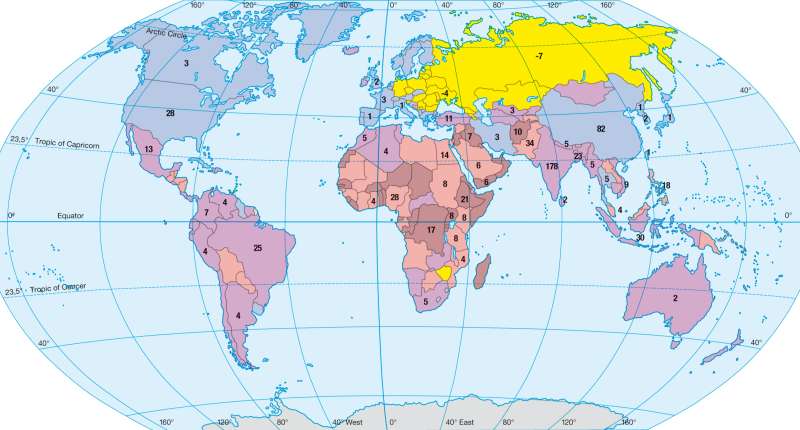Population development
The world - Population
978-3-14-100790-9 | Page 190 | Ill. 2

Information
The map gives an overview of the varying intensity of biological population growth in the various states and regions of the world. The factors of fertility and mortality, the balance of which result in natural population growth, are divided into groups, which facilitates typing.Natural population growth and migration
What is striking is the gap between the industrialised countries with low fertility and mortality rates, and the developing countries with high fertility and mortality. In developed countries, both rates are close together. This results either in minimal population growth or stagnation, in some cases even a decline in population. The latter applies, among others countries, to Germany, where the mortality rate has declined mainly because of improved medical care, but the birth rate has fallen even more. However, in developing countries, in which the number of births significantly exceeds the number of deaths, the growth rate is relatively strong. The illustrated population growth for the developing countries is most visible on the African continent.
The numbers represented here, which reflect the annual growth of a state, include international migration. These migrations are from economically depressed to economically stronger areas and refugee movements, which, while often temporary, must be highlighted. In some industrialised countries like Sweden, migration determines/influences the population growth more than the natural growth. Otherwise, the medium- to longer-term demographic trends of a state are largely influenced by the development of fertility and mortality rates. The figures give an idea of how physically different a population grows in absolute terms and which economic and social actions must be taken arise from them.
The demographic transition model
As an explanation for the regional differences in population growth, the model of demographic transition is often used. This is based on the interdependence between economic growth and generative behaviour of the population of a state. It should be noted that this model only represents the process of population growth, but reveals nothing about the duration of the individual state at any certain stage.
The agrarian society with varying fertility and mortality rates are a starting point for this model and a period of consistently high birth rates is followed by rapidly falling death rates. This is caused by "early transition" with slight improvements in the areas of nutrition, health and hygiene, in conjunction with a weak industrial development rate and traditional reproductive behaviour. The ensuing "mid transition phase", also known as the phase of demographic transition is characterised by a slight decline in birth rates and a further drop in death rates. The growing industrialisation causes a softening of the traditional pattern of behaviour.
In the fourth phase, the "late transition" of the demographic transition is completed. The final "post transition" in which the modern industrial nations find themselves, is characterised by a lower birth rate and death rate. It is accompanied by a high standard of living and strong social and economic guarantees.
The problem of food or the profitability margin of the world becomes problematic in the context of demographic trends for many scientists. After the United Nation's latest report on world food, mankind would with the present development of productivity, be in a position to feed more than double the current world population. The problem is therefore less a lack of objective, but rather that of an extremely unequal distribution of and access to food.
A: H.-J. Kolb; Ü: Colette Fleming




